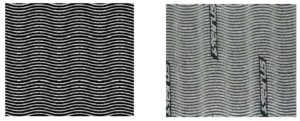In its November 13, 2019 decision in Columbia Sportswear v. Seirus, the Federal Circuit addressed the issue of whether the presence of a logo in the accused design should be considered when assessing infringement of a design patent and found that the district court erred in granting summary judgement without considering the impact of a logo. On March 5, 2020, Columbia’s subsequent bid for an en banc rehearing was denied by the Federal Circuit. We review here the Federal Circuit’s resolution of this issue and its implications.
Columbia owns D657,093 (the ‘093 patent) for a wavy design of heat reflective material applied to articles of clothing and footwear. Columbia alleged infringement by a similar wavy design on a similar material included in various Seirus products, including boots and jackets. The claimed design and the allegedly infringing design are shown below. The district court granted Columbia’s motion for summary judgement of infringement and the jury thereafter awarded Columbia over $3 million in damages.

(a) Claimed Design (b) Allegedly Infringing Design
In deciding summary judgment in Columbia’s favor, the district court rejected Seirus’s argument that there were significant differences between the patented design and the accused pattern. In opposing summary judgment, Seirus pointed to differences in wave thickness, spacing and orientation along with the presence of its logo throughout the accused pattern. With respect to the latter difference, the district court held that logos should be wholly disregarded in the infringement analysis, relying on L.A. Gear v. Thom McAn Shoe Co., 988 F2d 1117 (Fed. Cir. 1993).
On appeal, the Federal Circuit disagreed with district court’s decision to grant summary judgment and vacated finding of infringement of the design patent. The Federal Circuit held that the district court improperly resolved disputed fact issues relating to infringement that should have been decided by the jury. These issues include the effect that differences in the wave thickness, spacing and orientation would have on the ordinary observer. According to the Federal Circuit, “whether an element of Serius’s design would give an ordinary observer a different visual impression than Columbia’s design” should be resolved by the jury on remand.
With respect to the logo, the Federal Circuit found that the district court improperly failed to consider the effect of Seirus’s logo in determining whether Seirus’ products infringed the ‘093 design patent. The Federal Circuit rejected the argument that L.A. Gear prohibits consideration of an ornamental logo, its placement, and its appearance in determining infringement. It held that reading L.A. Gear so broadly would be inconsistent with the fact finder’s task of determining whether an ordinary observer would find “the effect of the whole design the same.”
The Federal Circuit’s narrow interpretation of L.A. Gear, and its reasoning on the facts here, strongly suggests that logo placement can be an important factor in assessing design patent infringement, particularly when the logo is an integral part of the accused design. In light of this, an infringer could potentially avoid infringement through logo placement on the allegedly infringing design.
While time will tell what impact Columbia Sportswear v. Seirus has in design patent litigation, it stands as a reminder that design patent infringement is a fact question that turns on the overall visual impression of the ordinary observer based on the design patent, the prior art, and the accused design. The Federal Circuit’s opinion indicates and reflects a predisposition against rules that would interfere with this fact finding.

